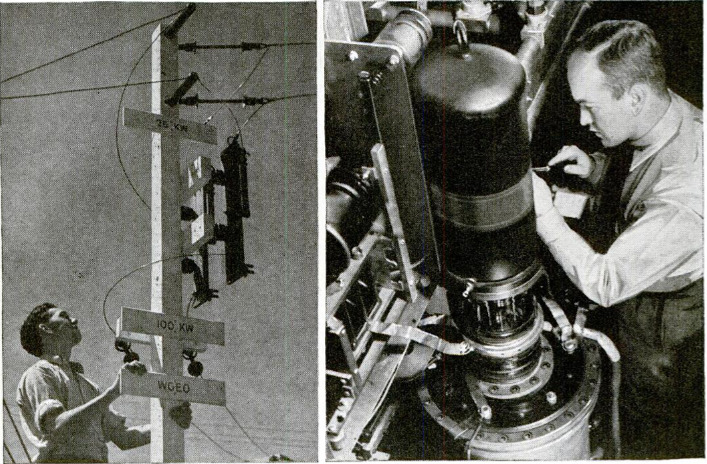THERE’S a world-wide war of ideals being waged in the air, and Uncle Sam’s in the thick of it. The battle of beams is foughtaround the clock. The nation’s great short-wave broadcasting stations fling out broadsides of truth to explode over Europe, Latin America and the Far East, and blast away at propaganda unfavorable to American customs, beliefs, products and policies. It's a conflict that started years before Nazi troops marched into Poland, It will certainly continue through the current war and probably through the post-war contest for trade, regardless of the outcome of hostilities. One of the most spirited “armament” races in the world is going on in the laboratories and factories where radio transmission instruments are conceived and manufactured. Determined to meet word with word, kilowatt with kilowatt, Uncle Sam has told this nation’s short-wave stations, many of which were too weak to reach foreign countries effectively, to step up their power or step out of the picture. A few stepped out, but ten stations are spending more than $2,000,000 to bring their transmitters up to the 50 kilowatt minimum power standard ordered by the Federal Communications Commission. Two others already qualify. Though American engineers were the first to discover the advantage of short waves for transmission over great distances, few Americans took notice of the shafts aimed at this country during the pre-war years from suddenly powerful European stations. These propaganda broadcasts told South America the United States was imperialistic; told Asia that America had designs on China. It was not until 1939 that Uncle Sam had a voice equal to the overseas transmitters. Early in that year, General Electric, which since 1923 has operated short-wave stations at Schenectady, N. Y., equipped WGEO for 100-kilowatt operation, making it the most powerful short-wave station in the hemisphere. Two 100-kilowatt tubes with demountable filaments, the first ever made, were built for the station. At the same time special double panel antennas, designed by Dr. Ernest F. W. Alexanderson, which increase signal strength 10 to 20 times in a given direction, went into service on WGEO and a sister station, WGEA, in Schenectady, directed on London, Rio de Janeiro and Buenos Aires. General Electric also added a third short-wave station, KGEIL at San Francisco, beamed alternately on Latin America and the Orient. Other American short-wavers began to improve stations and programs. Meanwhile, in the bitterness of war, anti-American radio tactics became even more disagreeable and Europe began to broadcast propaganda all over the dial. Finally Uncle Sam got mad. Surveying his armaments in this war of words, he found only WGEO and the Crosley Corporation’s WLWO in Mason, O.,now increasing from 50 to 75 kilowatts, with power enough to cut through the tropical static to South America under all conditions. A few months ago came the order to speak up to at least 50 kilowatts, or to shut up. Those speaking up are: World Wide's WRUL and WRUW, Boston; Columbia’s WCBX, on an island in Long Island Sound, and WCAB, Philadelphia; National Broadcasting Company’s WNBI and WRCA at Bound Brook, N. J.; Westinghouse’s WBOS and WPIT, and General Electric’s WGEA and KGEL. No governmental control over programs has been established despite the diplomatic nature of the foreign contacts. The short-wave stations will not meet dirt with mud, but present news and facts, a policy, which is certain to stand out in the scrambled mess of lies, insinuations, fakes and jibes which characterizes the battle of beams. American stations pretty closely follow the standards set by the General Electric programs which avoid out-and-out propaganda and are heavy on education and entertainment. Controversies are avoided and from Schenectady to Europe, in English and French, and to South America in Spanish and Portuguese go spot news, music which leans toward the symphonic, scientific talks, educational programs, interviews, market quotations, translations of speeches by important personages, sports, Holly- wood chats, travel talks, English lessons, children’s programs, mailbags for explorers and rebroadcasts of network programs. Similar programs go to Mexico and western South America and to Asia and Australia from KGEI in San Francisco. This station also conducts a mailbag program through which friends communicate with missionaries all over the world. The daily reward comes in hundreds of letters of thanks. During bombing raids, when their own stations are silent, an Englishman writes that American short-wave sprograms entertain groups huddled in the shelters. A trader in Colombia tells of placing a loud speaker in the village plaza and furnishing music for a dance. An oil man writes of news bulletins received in the jungles of the Dutch East Indies. A letter to KGEI from an American newspaper man, after a tour of the Far East, sums it up: “People I've talked to, even in India, appreciate the news service, the music and entertainment. It's hard to explain how much American programs mean to these people, cut off from the rest of the world, with censorship rampant. The most important thing is unbiased American news.” From these stations that are raising their voices for America, the national anthem will float proudly on the air to the further- most corners of the world as soon as Uncle Sam gets his electronic sleeves rolled up. And it won’t be long now.


